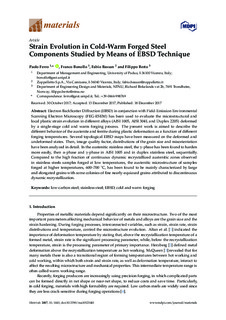Strain evolution in cold-warm forged steel components studied by means of EBSD technique
Journal article, Peer reviewed
Published version
Permanent lenke
http://hdl.handle.net/11250/2559250Utgivelsesdato
2017Metadata
Vis full innførselSamlinger
Originalversjon
10.3390/ma10121441Sammendrag
Electron BackScatter Diffraction (EBSD) in conjunction with Field-Emission Environmental Scanning Electron Microscopy (FEG-ESEM) has been used to evaluate the microstructural and local plastic strain evolution in different alloys (AISI 1005, AISI 304L and Duplex 2205) deformed by a single-stage cold and warm forging process. The present work is aimed to describe the different behavior of the austenite and ferrite during plastic deformation as a function of different forging temperatures. Several topological EBSD maps have been measured on the deformed and undeformed states. Then, image quality factor, distributions of the grain size and misorientation have been analyzed in detail. In the austenitic stainless steel, the γ-phase has been found to harden more easily, then α-phase and γ-phase in AISI 1005 and in duplex stainless steel, sequentially. Compared to the high fraction of continuous dynamic recrystallized austenitic zones observed in stainless steels samples forged at low temperatures, the austenitic microstructure of samples forged at higher temperatures, 600–700 °C, has been found to be mainly characterized by large and elongated grains with some colonies of fine nearly-equiaxed grains attributed to discontinuous dynamic recrystallization.

